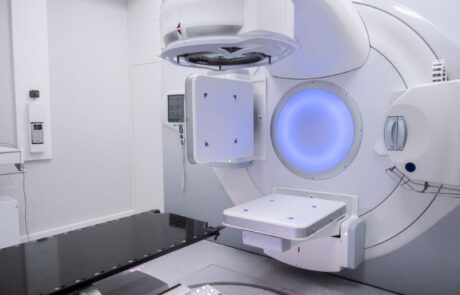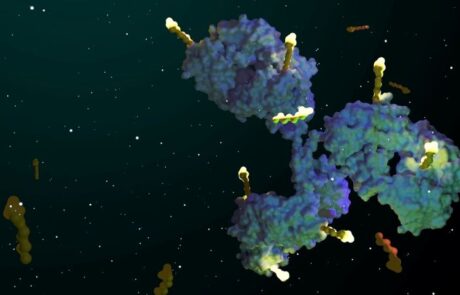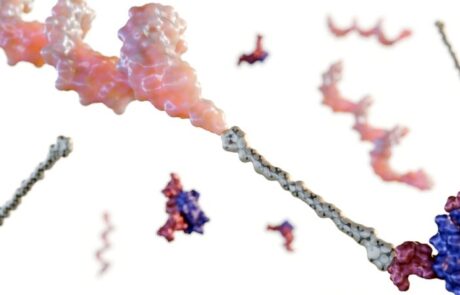
New myosin inhibitors can drug the brain without stopping the heart.
By Laurel Oldach
A decade ago, when Dr Courtney Miller found that blocking non-muscle myosin II (NMII) can interrupt methamphetamine addiction in mice, it was difficult to imagine drugs targeting that protein ever coming to the clinic. But recent studies describe her work developing a lead candidate for treating methamphetamine use disorder and provide data to show that a related compound for treating glioblastoma is ready for clinical trials.

Preventing radiation damage with melanin-based material.
By Soumya Sagar
Radiotherapy for abdominal and pelvic cancers almost always leads to small-intestine injuries that are difficult to heal, eroding the quality of life of patients. To counteract this, researchers have developed an orally consumable material made from melanin—the pigment in our skin that protects us from ultraviolet rays—that can shield the intestines from ionizing radiation.

Modelling of clinical TQT studies outcomes from preclinical cardiovascular safety pharmacology studies using the one-step QTc model.
By Pascal Champéroux et al.
Retrospective translational analyses have shown a high rate of false negatives between clinical thorough QT studies (TQT) and preclinical cardiovascular safety pharmacology studies. The aim of this work was to model the results of clinical TQT studies from cardiovascular safety pharmacology studies in beagle dogs. Results prove that it can improve the translational value of preclinical cardiovascular safety pharmacology studies and reduce the risk of false negatives.

Legacy hERG study data in contemporary integrated risk assessments – mitigating the risk of protocol and positive control article differences.
By Richard W. Daniels et al.
Testing new molecules against the hERG potassium channel has been a routine component of secondary pharmacology assessments for more than a quarter of a century. ICH S7B guidance in 2005 required a GLP hERG study, and in 2022 they introduced some ‘best practice’ recommendations for hERG assessment. This article sought to examine whether the differences in practice warranted retesting the compounds or could dispel a concern that prior practice had been less sensitive.

Targeted but Toxic? Addressing the Safety Challenges of Antibody-Drug Conjugates in Metastatic Breast Cancer.
By Suchandrima Bhowmik
Antibody-drug conjugates (ADCs) are an evolving class of targeted cancer therapy that combines a monoclonal antibody with a cytotoxic payload or agent via chemical linkers. They have shown significant efficacy in treating breast cancer. However, treatment-related toxicity, mainly from off-target effects of cytotoxic payloads and unintended bystander damage, remains a concern. Some of the common toxicities/adverse events associated with ADCs and their management are addressed in this article.

Using pre-existing control data to set expectations in preclinical studies.
By Jenna K. Felli et al.
This work presents a conceptual approach to limit the use of live subjects for preclinical toxicological studies by leveraging pre-existing control data. Given a valid set of pre-existing control data, one can use probabilistic methods to set expectations for targeted study outcomes prior to undertaking a study. These probabilistic approaches can help investigators understand the behaviour of endpoints in an untreated population and help set a priori expectations when interrogating study results.

An explorable model of an adverse outcome pathway of cytokine release syndrome related to the administration of immunomodulatory biotherapeutics and cellular therapies.
By Alexander Mazein et al.
Cytokine release syndrome (CRS) is a potentially severe systemic inflammatory condition triggered by various immunomodulatory therapies, making understanding its pathogenesis critical for improving patient outcomes. By combining immunotoxicology and systems biology approaches, we offer a novel and integrative conceptual model of CRS as an adverse outcome (AO), induced by five different immunomodulatory biotherapies.

Multi-laboratory comparisons of manual patch clamp hERG data generated using standardized protocols and following ICH S7B Q&A 2.1 best practices.
By Claudia Alvarez Baron et al.
Acute block of hERG channels is the most common mechanism underlying drug-induced QTC prolongation and potentially fatal Torsade de Pointes arrhythmia. To interpret the hERG results, understanding hERG assay reproducibility or hERG data variability is pivotal. In this study, 5 laboratories tested 28 drugs and results indicate that hERG block potency values within 5X of each other should not be considered different.

A platform approach as a plausible option for nonclinical safety assessment of adjuvanted vaccines.
By Eric Destexhe
Vaccine platform technologies are reproducible, standardized manufacturing and development methods that may be leveraged to streamline regulatory approval of new vaccines. To evaluate the plausibility of a platform approach for the nonclinical safety assessment of adjuvanted recombinant-protein vaccine candidates, a comparative analysis was performed on repeat-dose toxicity data from five rabbit studies. Findings support the plausibility of such an approach, potentially reducing animal use and expediting first-in-human trials.

Postmarket review of photosensitivity associated with select BRAF and MEK inhibitors.
By Nicholas Chow et al.
During postmarketing safety surveillance, the authors identified cases of photosensitivity with BRAF inhibitors and MEK inhibitors and evaluated this finding further using data from the FDA’s Adverse Event Reporting System, the literature, and the drug manufacturers. case series suggest a causal association between BRAFi/MEKi and photosensitivity, and this is further supported by pre-market, non-clinical testing results.

Review on organ-on-chips for medicines safety assessment: A European regulatory perspective.
By Joana M. D. Portela et al.
This review examines a decade (2010-2020) of organ-on-chip (OoC) development, focusing on their application in the non-clinical safety assessment of medicinal products. It includes a detailed description of the types of OoCs, the organs, tissues and interactions mimicked, as well as their various applications. A broad range of organs and combinations of organs were modelled in the reviewed OoCs, with the liver, kidney and heart being the most frequently mimicked.

Off-target effects of oligonucleotides and approaches of preclinical assessments.
By Haiwen Ruan et al.
Oligonucleotide-based therapies, such as antisense oligonucleotides (ASOs), small interfering RNAs (siRNAs), represent a class of therapeutic agents that specifically target gene transcription or translation mechanisms through sequence specificity. Despite significant promise in the treatment of genetic disorders, unintended toxicity continues to pose a considerable challenge and remain a critical safety concern in the development of oligonucleotide therapeutics (ONTs).
